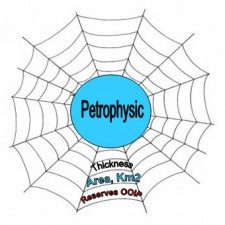Wireline Logging Interpretation & Petrophysical Evaluation
Even the wireline loggings’ signatures are affected by anomalies and artefacts related to the environmental conditions of the hole, they remain carrying invaluable information for the driller, the geologist, the petrophysicist, the reservoir engineer and the geophysicist.
Since wireline logging data are costly acquired, we don’t satisfy to just derive from them only porosity & water saturation.
A beneficial exploitation of the wireline logging should cover the following phases:
- To establish an adequate cost effective logging program matching the hole conditions,the formations characteristics and company objectives;
- Quality control of the logs during and after recording;
- Quantitive analysis and interpretation which consist of a petrophysical evaluation, a geological interpretation and cased hole interpretation.

Advanced Petrophysics Evaluation
– If we assume the reservoir analysis like a cobweb, petrophysic constitutes its core. -Petrophysical analysis is not limited to an effortless estimate of porosity and water saturation. Which logs derived porosity do you choose between Density, Neutron and Sonic? Why?
– Did you know that the water saturation from Archie formula is also depending on sensitive parameters like the lithological coefficient “a” and cementation factor “m” which is, in its turn, depending on fracture density of the reservoir?
– You know, the reserves volume you use for the economic evaluation of your project is strictly contolled, first, by petrophysical parameters such as porosity, water saturation, clay volume, and cut-off to be applied for each parameter.
– Do you know in case of low porosity tight reservoirs (like Hamra Quartzites in Algeria), to choose between 6% or 5% as porosity appears as a slight difference but (all other parameters being unchanged) reserves will change up to more or less 20%. You certainly know very well the impact on the NPV & IRR.
FAQ
⇒ How to compute and choose the best petrophysical characteristics to avoid overestimating or underestimating of your Oil & Gas reserves and then your NPV?
⇒ How to determine the different cut off of petrophysical characteristics to eliminate uneconomic sections?
Let 30-year experience answer
Geological Analysis and interpretation
In addition to petrophysic, we can go further to derive informations from logging curves along which we can read and approach the main geological features and characteristics such as:
- Lithology,
- Unconformities,
- Faulting,
- Fracturing,
- Formation dipping,
- Sedimentological environment deposit approach
Others analysis and interpretations
- Temperature’s gradient :Some logging tools can not support high temperatures and pressure so that it is important to know the predicted temperature at a given depth. The knowledge of the geothermic gradient is also necessary for the estimate of gas reserves, to approach the history of the evolution of the sedimentary basin, etc.
- Pressure’s gradient & reservoir’s pressure prediction: Pressure gradient can detect different fluids contacts (GOC, OWC) with high accuracy. Also, pressure gradient is used to estimate the needed mud density before drilling….etc
- Selection of testing and perforating zones:The selection of the intervals to be perforated and tested, based on petrophysical cut-off as well as the choice of the perforation mode (type of charge, shooting density, penetrarion…) is primordial for the appreciation of the right performance of the reservoir.
- Cementing quality control: A bad cementing can cause a natural damage in case of presence of aquifers and saliferous layers as well as gas reservoirs. In Algeria, there is a specific law which controls stricly this aspect in particular the protection of the aquifers. The cementing quality control is not limited to a simple reading of the CBL curve.
When the experience at wireline logging analysis becomes a thoughtful art rather than a blind technique.

